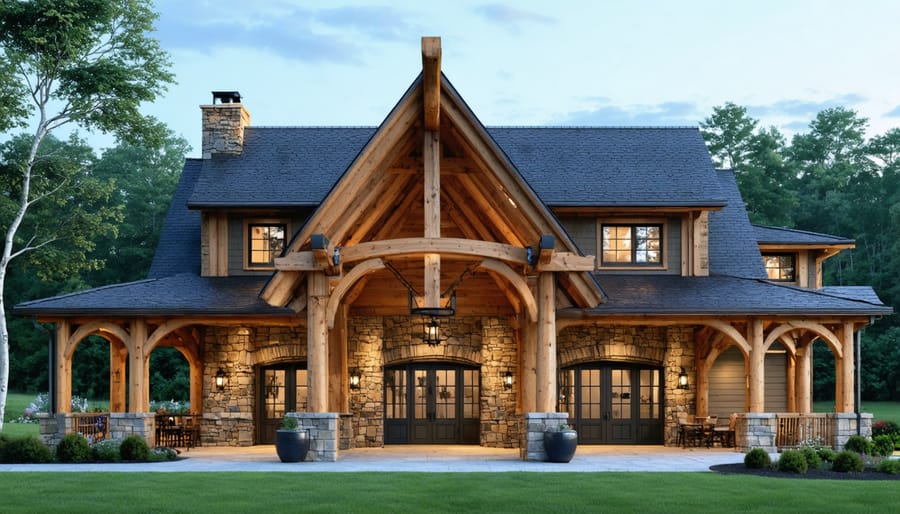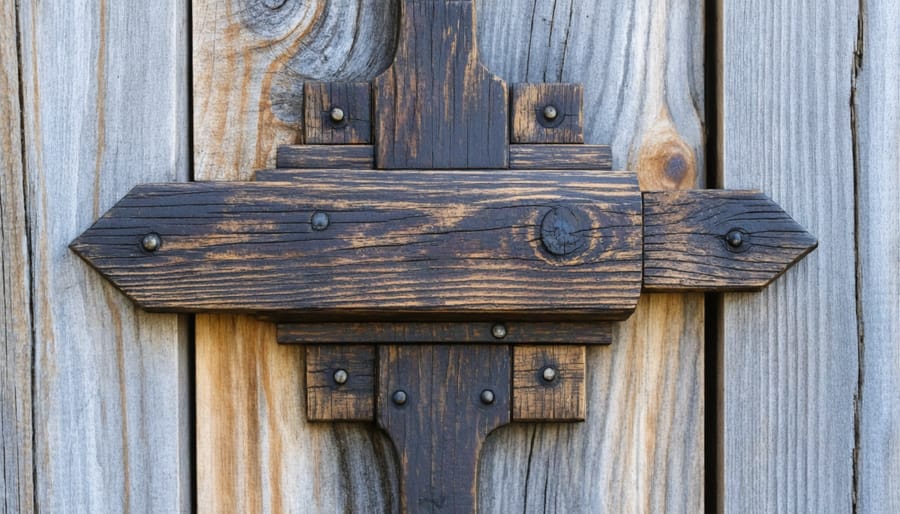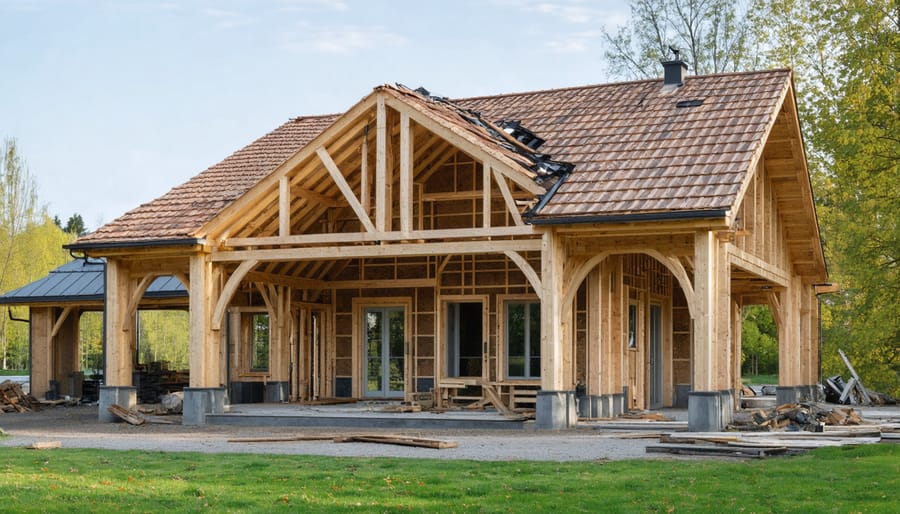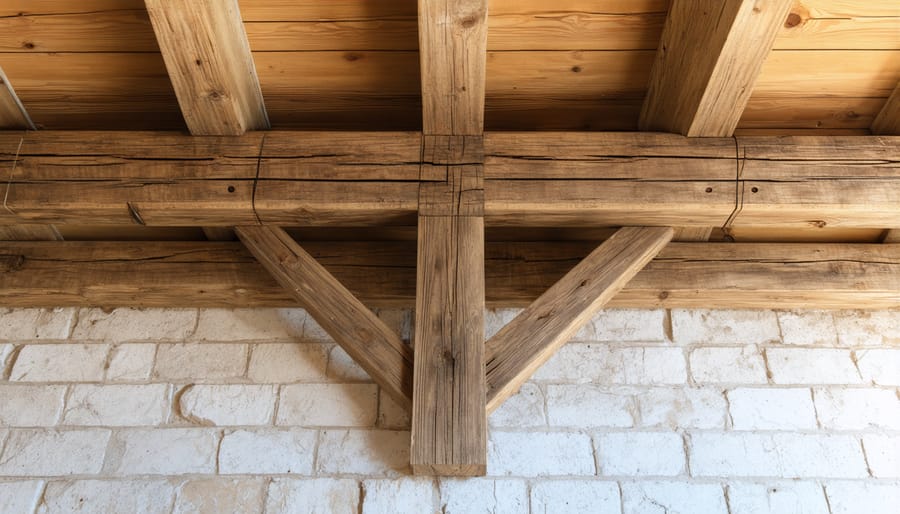
Timber framing stands as one of architecture’s most enduring and sophisticated building techniques, combining structural integrity with timeless aesthetic appeal. This centuries-old craft merges precision joinery with massive wooden beams to create frameworks that can last generations, requiring no mechanical fasteners or nails. Modern builders increasingly embrace these traditional methods, recognizing their superior strength, sustainability, and architectural beauty.
From the distinctive mortise-and-tenon joints to the elegant curved braces that characterize medieval European structures, timber frame techniques represent more than just construction methods – they embody a profound understanding of wood’s natural properties and structural dynamics. Today’s craftsmen blend these time-tested approaches with contemporary engineering principles, creating buildings that honor historical traditions while meeting modern performance standards.
Whether restoring a historic barn or constructing a new custom home, understanding timber frame techniques provides essential insights into one of construction’s most versatile and resilient building systems. These methods not only preserve cultural heritage but also offer practical solutions for sustainable, long-lasting structures that appreciate in both value and character over time.
At the heart of timber frame construction lie the traditional joinery methods that have proven their worth over centuries. The mortise and tenon joint, often called the cornerstone of timber framing, creates exceptionally strong connections by fitting a projecting tenon into a precisely carved mortise pocket. This technique is particularly effective for joining posts to beams and rafters to plates.
Scarf joints enable craftsmen to extend timbers horizontally, essential when working with longer spans. The halved scarf joint, featuring interlocking teeth and secured with wooden pegs, provides both strength and aesthetic appeal. Dovetail joints, recognized by their distinctive wedge shape, excel in resisting pull-apart forces while maintaining structural integrity.
Lap joints offer another reliable connection method, where two pieces overlap and are secured with pegs or spikes. These joints are commonly found in roof trusses and bracing elements. Modern timber framers still rely on these time-tested techniques, though they may enhance them with contemporary tools and engineering principles to meet current building standards.

Throughout history, certain wood species have proven themselves exceptional for timber frame construction, each bringing unique characteristics to the craft. Oak has long been the premier choice in European timber framing, particularly in England and France, due to its remarkable strength, durability, and resistance to decay. Its dense grain structure and high tannin content naturally protect against insects and fungal growth.
In North America, Eastern White Pine gained prominence among early settlers for its accessibility, straight grain, and ease of working. Despite being softer than oak, properly maintained pine frames have demonstrated impressive longevity, with many colonial-era structures still standing today.
Douglas Fir emerged as another popular choice, especially in the Pacific Northwest, offering an excellent strength-to-weight ratio and natural resistance to warping. Its long, straight growth pattern made it ideal for creating substantial structural beams.
Other historically significant species include Chestnut, prized for its rot resistance before its near-extinction in North America, and Cedar, valued for its natural oils that deter pests and decay. Each of these traditional species continues to influence modern timber frame construction, though availability and sustainability considerations now play crucial roles in species selection.
Regular inspections can reveal several common structural issues in historic timber frames. Water damage is often the primary culprit, manifesting as dark stains, soft spots, or visible rot, particularly around joints and connection points. Look for signs of insect infestation, such as small holes, sawdust-like debris, or hollow-sounding timber when tapped.
Structural movement may be indicated by gaps in joints, leaning posts, or sagging beams. Pay special attention to areas where timber meets masonry, as these locations are prone to moisture-related deterioration. Cracking or splitting in major beams, especially along the grain, can signal stress or overloading issues.
Poor previous repairs are another concern to watch for. These might include inappropriate modern materials, improperly sized replacement timbers, or makeshift supports that don’t address the underlying problem. Check for missing or damaged pegs in mortise and tenon joints, as these are crucial for structural integrity.
The roof structure deserves particular scrutiny, as failing joints here can lead to wider structural problems. Look for deflection in purlins and ridge beams, and ensure that tie beams are properly connected to wall plates.

Proper documentation is essential for successful timber frame restoration projects. The process typically begins with detailed photographs of all structural elements, capturing both overall views and close-ups of specific features, damage, or unique characteristics. Measurements are meticulously recorded using both traditional methods and modern tools like laser scanners and digital mapping systems.
Detailed sketches and drawings are created to document the existing conditions, including joint configurations, timber dimensions, and any signs of deterioration. These drawings serve as the foundation for restoration plans and help identify areas requiring immediate attention.
A condition assessment report accompanies the visual documentation, noting the type and extent of damage, previous repairs, and any modifications to the original structure. This report often includes moisture content readings, structural analysis results, and recommendations for treatment.
Modern documentation techniques also incorporate 3D modeling software, which allows restoration teams to create precise digital representations of the timber frame. These models help visualize the restoration process, plan complex repairs, and create accurate material lists while serving as valuable historical records for future reference.
Sister joinery is one of the most effective expert wood repair techniques used to strengthen and restore damaged timber frame elements. This method involves carefully joining new timber alongside the existing damaged piece, creating a strong, lasting bond that maintains the structural integrity of the frame.
The process begins by carefully cleaning and preparing the damaged section of timber. A new piece of wood, matched in species and moisture content to the original, is then shaped to fit precisely against the damaged area. The two pieces are joined using traditional mortise and tenon joints, along with specialized fasteners or wooden pegs, depending on the specific requirements of the repair.
What makes sister joinery particularly valuable is its ability to preserve as much of the original timber as possible while providing the necessary structural support. This technique is especially useful in historic restoration projects where maintaining authenticity is crucial. The new timber effectively shares the load with the original piece, preventing further deterioration and extending the life of the structure.
Property owners should note that successful sister joinery requires careful assessment of the damage extent and precise matching of materials. When properly executed, these repairs can last for decades while maintaining the historical and structural authenticity of the timber frame.

Splice repairs are essential techniques for preserving timber frame structures when localized damage occurs. Rather than replacing entire beams or posts, these methods allow craftsmen to remove only the compromised sections while maintaining the structural integrity of the frame.
The most common splice repair is the scarf joint, where damaged timber sections are carefully cut away at an angle, typically between 1:8 and 1:12. The replacement piece is precisely measured and cut to match the original timber’s dimensions and angle. Traditional woodworking techniques, such as mortise and tenon joints or half-lap joints, are often incorporated into the splice to enhance structural stability.
For successful splice repairs, matching the grain orientation and wood species of the original timber is crucial. The new timber should be properly seasoned to prevent future warping or shrinkage. Structural engineers often specify additional reinforcement methods, such as steel plates or carbon fiber, to ensure the splice meets or exceeds the original beam’s strength.
Modern epoxy consolidation can complement traditional splice repairs, especially in areas where moisture damage has occurred. This hybrid approach combines historical craftsmanship with contemporary materials, providing lasting solutions that respect the structure’s historical significance while ensuring its continued stability.
Before undertaking any splice repair, it’s essential to identify and address the root cause of the damage to prevent future deterioration. Proper drainage, ventilation, and regular maintenance will help protect the restored timbers for generations to come.
Joint restoration in timber frame structures requires a delicate balance of traditional craftsmanship and modern techniques. When addressing deteriorated joints, the first step is carefully dismantling the affected area while preserving as much original material as possible. Traditional joints like mortise and tenon connections often suffer from water damage or structural stress over time.
A common restoration technique involves splicing new timber into the damaged section using precisely matched wood species and moisture content. This method, known as scarfing, creates a strong bond while maintaining the structure’s historical integrity. For minor repairs, epoxy consolidants can stabilize weakened wood fibers, while larger voids may require custom-carved wooden patches secured with traditional wooden pegs.
Metal reinforcement plates, when thoughtfully implemented, can provide additional support without compromising the authentic appearance. However, it’s crucial to use compatible materials that won’t cause future degradation through chemical reactions or moisture retention.
Before undertaking any joint restoration, thorough documentation of the original construction methods is essential. This includes photographing, measuring, and creating detailed drawings of existing joints. Modern tools like moisture meters and endoscopes help assess the full extent of damage within joints, ensuring repairs address all underlying issues.
Success in joint restoration often depends on proper environmental control during and after repairs. Maintaining consistent humidity levels prevents future joint movement and ensures the longevity of restoration work.
In timber frame restoration, selecting the right materials is crucial for maintaining historical authenticity while ensuring structural integrity. Traditional timber frames typically utilized local hardwoods such as oak, chestnut, and maple, chosen for their durability and resistance to decay. When undertaking restoration work, it’s essential to match both the wood species and aging characteristics of the original materials.
Modern professional restoration practices often incorporate a mix of traditional and contemporary materials. While original timber should be preserved whenever possible, replacement pieces must be carefully selected for compatibility. Look for wood with similar grain patterns, moisture content, and aging properties to ensure seamless integration with existing elements.
Quality considerations extend beyond the timber itself. Traditional joinery techniques require specific fasteners and connecting elements. Hand-forged nails, wooden pegs, and historically accurate hardware should be sourced from reputable suppliers specializing in period-appropriate materials. For structural reinforcement, modern preservatives and treatments can be selectively applied, provided they don’t compromise the building’s historical integrity.
When selecting materials, consider factors such as local climate conditions, intended use, and load-bearing requirements. Documentation of original materials through photographs and detailed notes helps ensure accuracy in matching replacement components, maintaining both the aesthetic and structural authenticity of the timber frame structure.
The restoration of historic timber frame structures must adhere to strict preservation standards to preserve heritage value while ensuring structural integrity. Current guidelines emphasize the importance of maintaining original materials whenever possible, with replacements limited to severely degraded components that compromise structural safety.
The Secretary of the Interior’s Standards for Rehabilitation serves as the primary framework in the United States, requiring documentation of existing conditions, minimal alterations to defining characteristics, and the use of historically accurate materials and techniques. Restoration work must be reversible, allowing future conservators to undo modifications if better techniques emerge.
Professional certifications from organizations like the Timber Framers Guild are often required for contractors working on historic structures. These certifications ensure practitioners understand both traditional joinery methods and modern conservation principles.
Key regulations include:
– Documentation of all modifications
– Use of period-appropriate tools and techniques
– Matching of original wood species and grain patterns
– Chemical treatment restrictions
– Regular maintenance schedules
– Moisture control requirements
– Ventilation specifications
Property owners should consult local historic preservation boards before beginning any restoration work, as requirements can vary by jurisdiction and landmark status. Regular inspections by qualified professionals help ensure compliance with preservation standards while maintaining the structure’s historical authenticity.
The preservation and restoration of timber frame structures represent a vital intersection of traditional craftsmanship and modern conservation techniques. Throughout this exploration of timber frame techniques, we’ve seen how proper assessment, material selection, and skilled execution are crucial for successful restoration projects. The enduring appeal of timber frame construction lies not only in its structural integrity but also in its historical significance and aesthetic value.
Whether dealing with mortise and tenon joints, addressing decay, or implementing preventive measures, each aspect of timber frame restoration requires careful attention to detail and respect for traditional methods. The combination of time-tested techniques with contemporary preservation approaches ensures these architectural treasures remain sturdy and beautiful for future generations.
Property owners and managers must remember that successful restoration begins with thorough assessment and planning. Working with qualified professionals who understand both historical construction methods and modern conservation principles is essential. Regular maintenance, proper moisture control, and early intervention against potential issues will significantly extend the life of timber frame structures.
As we continue to value and preserve our architectural heritage, the importance of proper timber frame restoration techniques cannot be overstated. By maintaining these traditional building methods while embracing appropriate modern innovations, we ensure that these remarkable structures continue to stand as testaments to both historical craftsmanship and contemporary preservation expertise.